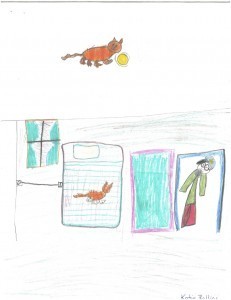Terry Farish's Blog, page 27
February 15, 2013
“An Educator’s Guide” for The Good Braider
Thomas Talarico, author of “The Good Braider, An Educator’s Guide,” teaches  English to immigrants and refugees at Portland High School in Maine. The “Educator’s Guide” makes the novel accessible to immigrant and refugee students, themselves, as they study to become proficient readers in English. Thomas links extension activities to Common Core Standards.
English to immigrants and refugees at Portland High School in Maine. The “Educator’s Guide” makes the novel accessible to immigrant and refugee students, themselves, as they study to become proficient readers in English. Thomas links extension activities to Common Core Standards.
Detailed comprehension questions guide readers through the novel’s three parts. Project ideas invite students to look more deeply into themes of the book. One activity is to research and do a presentation about the many kinds of African braid. Another activity is on the very hard theme of rape as an act of war. I am very grateful to have Thomas’s experienced eye on the novel to offer ways to make the book accessible to readers and support them as they think about Viola’s difficult journey.
Thomas served as a Peace Corps volunteer in the Philippines where he lived with the Ifugao, a tribal minority who have terraced the steep mountain terrain and grow some of the country’s most delicious and traditional rice. Tom gets his inspiration from the many students who have shared their stories with him and have allowed him to be part of their young lives as they navigate high school and the multiple identities they are juggling. He is an amateur ethnobotanist and thrives on learning about plants when he travels. As a Fulbright-Hays scholar in Mexico and Costa Rica, Tom developed an ethnobotany unit for English Language Learners. Tom can be reached at tomtal207@yahoo.com with comments and/or questions.
Portland High Teacher Writes “An Educator’s Guide” for BRAIDER
Please meet Thomas Talarico. Thomas is the author of The Good Braider, An Educator’s Guide. He teaches  English to immigrants and refugees at Portland High School in Maine. Tom served as a Peace Corps volunteer in the Philippines where he lived with the Ifugao, a tribal minority who have terraced the steep mountain terrain and grow some of the country’s most delicious and traditional rice. Tom gets his inspiration from the many students who have shared their stories with him and have allowed him to be part of their young lives as they navigate high school and the multiple identities they are juggling. He is an amateur ethnobotanist and thrives on learning about plants when he travels. As a Fulbright-Hays scholar in Mexico and Costa Rica, Tom developed an ethnobotany unit for English Language Learners. Tom can be reached at tomtal207@yahoo.com with comments and/or questions.
English to immigrants and refugees at Portland High School in Maine. Tom served as a Peace Corps volunteer in the Philippines where he lived with the Ifugao, a tribal minority who have terraced the steep mountain terrain and grow some of the country’s most delicious and traditional rice. Tom gets his inspiration from the many students who have shared their stories with him and have allowed him to be part of their young lives as they navigate high school and the multiple identities they are juggling. He is an amateur ethnobotanist and thrives on learning about plants when he travels. As a Fulbright-Hays scholar in Mexico and Costa Rica, Tom developed an ethnobotany unit for English Language Learners. Tom can be reached at tomtal207@yahoo.com with comments and/or questions.
The Educator’s Guide offers background information and questions to help students build comprehension as they read the novel. Thomas has also created a number of extension assignments to deepen students’ understanding of the immigrant experience and themselves. He has created the guide with high school students in mind including students in ESL classes. Here is The Good Braider Educators’ Guide
YALSA Best Fiction for Young Adults
 The Good Braider is on the American Library Association’s list of Best Fiction for Young Adults for 2013. Thank you, ALA!
The Good Braider is on the American Library Association’s list of Best Fiction for Young Adults for 2013. Thank you, ALA!
January 21, 2013
Journey to Kakuma and the Turkana People
Follow my journey to Kakuma, a village in the Turkana district of northern most Kenya. I volunteered with KVDA in the Kakuma Semi Arid Boarding Primary School where children of the nomadic Turkana people and children from Kakuma  Refugee Camp go to school. See images and follow the journey here.
Refugee Camp go to school. See images and follow the journey here.
December 30, 2012
Christmas Visits With The Cat

A child from Pittsfield, NH retells the story of The Cat Who Liked Potato Soup.
I have enjoyed Christmas class visits. I went to New Durham School in New Hampshire and met all the children, grades 1 -6. They are very fun to puzzle out with about what’s really going on in THE CAT WHO LIKED POTATO SOUP. The children are savvy. They see the truth about the old man who in the story claims to have no affection for his old cat. He complains about her. He calls her a “worthless cat. Never caught nothin’ Not a mouse, nothin’.” But the children read between the lines. They see the old man let her sleep on his electric blanket and he takes her bowls of potato soup. And they see the cat not willing to accept the man’s careless words. I ask the children, “Does the old man like his cat?” They look at the clues. “Does he miss the cat?” I ask, after the cat disappears and the old man is alone. They see a box of Kleenex on the table while the old man holds a spoon but cannot eat. “He’s sad,” the children say. ”He does like her.” I only read parts of the book in the assembly program I did at the school. After the assembly, a teacher took a copy of the book and read to her class. She told me later, “They got it. The children understood. They were able to see who the man really was.”
December 27, 2012
terry-farish-and-becky-rule-unh
December 22, 2012
Eleven Days Before I Go
 Paul Winter, of the organization Scottie’s Place, posted this photo on a blog. It is dated December 13, 2012. You can read the post, Life in Kakuma Refugee Camp. Scottie’s Place is an American-based nonprofit organization working to support the education of girls and young women in the camp, as well as many other sites. Paul Winter’s blog post is terribly sobering.
Paul Winter, of the organization Scottie’s Place, posted this photo on a blog. It is dated December 13, 2012. You can read the post, Life in Kakuma Refugee Camp. Scottie’s Place is an American-based nonprofit organization working to support the education of girls and young women in the camp, as well as many other sites. Paul Winter’s blog post is terribly sobering.
I am preparing to go to Kakuma Refugee Camp - in eleven days. From here on out, I am devoting this blog to my journey to Kakuma. It will become a more personal story.
December 2, 2012
Book Club Discussion Guide The Good Braider
This discussion guide includes background on the novel, a reference resource list, and general discussion questions for classes and book clubs.
Click to open the Book Club Discussion Guide for The Good Braider





